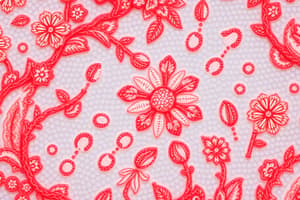Podcast
Questions and Answers
What is one of the essential functions of epithelial tissue mentioned in the text?
What is one of the essential functions of epithelial tissue mentioned in the text?
- Muscle contraction
- Energy storage
- Barrier function (correct)
- Temperature regulation
Which type of epithelial tissue consists of flat, scale-like cells?
Which type of epithelial tissue consists of flat, scale-like cells?
- Cuboidal epithelium
- Columnar epithelium
- Transitional epithelium
- Squamous epithelium (correct)
In which location would you typically find squamous epithelium?
In which location would you typically find squamous epithelium?
- Heart muscle
- Intestinal lining
- Surface of the skin
- Lining of the mouth and nose (correct)
What is one of the functions of epithelial cells apart from creating a physical barrier?
What is one of the functions of epithelial cells apart from creating a physical barrier?
Which function involves epithelial cells actively or passively absorbing nutrients?
Which function involves epithelial cells actively or passively absorbing nutrients?
Where can cuboidal epithelium be commonly found?
Where can cuboidal epithelium be commonly found?
Which type of epithelium is characterized by column-like cells?
Which type of epithelium is characterized by column-like cells?
What is the function of epithelial tissue on external surfaces?
What is the function of epithelial tissue on external surfaces?
In which location can mucous membranes be found?
In which location can mucous membranes be found?
Where are tubules lined with epithelial cells typically located?
Where are tubules lined with epithelial cells typically located?
Flashcards are hidden until you start studying
Study Notes
Epithelial Tissue: A Barrier and Interface
Epithelial tissue is a fundamental type of animal tissue that forms the outermost layer of our bodies and that of other multicellular organisms. As a dynamic and versatile structure, it plays essential roles in the maintenance of homeostasis, defense, and communication.
Functions of Epithelial Tissue
- Barrier function: Epithelial cells create a physical barrier, preventing the entry of foreign substances and pathogens while maintaining the integrity of internal environments.
- Selective permeability: The epithelium controls the passage of water, electrolytes, and nutrients across its surface, regulating the movement of molecules and maintaining proper hydration and nutrient balance.
- Protection: Epithelial cells protect underlying tissues and organs from mechanical damage, chemical irritants, and pathogens.
- Secretion: Epithelial cells secrete substances like enzymes, hormones, and mucus to facilitate various biological processes.
- Absorption: Epithelial cells can actively or passively absorb nutrients, water, and electrolytes from their environment.
Types of Epithelial Tissue
Epithelial tissues are categorized according to their cell shape, arrangement, and number of layers. Here are four primary types:
- Squamous epithelium: Consists of flat, scale-like cells, often found in thin layers, such as in the lining of the mouth and nose.
- Cuboidal epithelium: Consists of cube-shaped cells, often found lining ducts and tubules, such as in the kidneys and salivary glands.
- Columnar epithelium: Consists of column-like cells, often found in thick layers, such as in the lining of the stomach and small intestine.
- Pseudostratified epithelium: Features an irregular appearance, with cells of varying heights that resemble a stratified epithelium, but only one cell layer thick. This type is found in structures like the respiratory tract.
Location of Epithelial Tissue
- External surfaces: Epithelial tissue is found on the surface of the skin, covering the body's exterior as an effective barrier against the environment.
- Mucous membranes: Epithelial cells line the cavities and surfaces of internal organs, such as the respiratory tract, urinary tract, and digestive system, providing a protective barrier and facilitating transport of substances.
- Glands: Epithelial cells form the secretory component of glands, producing essential substances like mucus, enzymes, and hormones.
- Tubules: Epithelial cells line the tubular structures of the body, such as the nephrons in the kidneys and the ducts in sweat and salivary glands.
Epithelial tissue serves as a fundamental component of multicellular organisms, providing a barrier and enabling essential functions such as protection, secretion, and absorption.
Studying That Suits You
Use AI to generate personalized quizzes and flashcards to suit your learning preferences.




